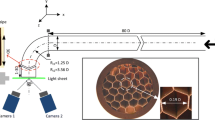Abstract
This paper reports an experimental investigation of the vortical structures in the pharynx/larynx region of an idealised human extra-thoracic airway obtained using particle image velocimetry (PIV). The inlet velocity was 0.13 m/s yielding a Reynolds number, based on the inlet condition, of 670. Two thousand images were acquired at each location at a framing rate of 2 Hz. The proper orthogonal decomposition method was applied to the PIV data. Only a few modes were used for POD reconstruction which recovered about 60 % of the turbulent kinetic energy. A vortex identification algorithm was employed to identify and measure properties of the structures. This step was followed by a statistical analysis of the distribution of number, size, and strength of these vortices. The results reveal the formation of a large number of structures identified along two planes in the pharynx/larynx region. This study also revealed an increased strength in the counter-clockwise structures as compared to clockwise structures in the pharynx region. As well, there is some evidence to suggest that the vortical structures, whose axes are perpendicular to the sagittal plane, change their orientation as they proceed further into the laryngeal region.
















Similar content being viewed by others
References
Adrian RJ (2007) Hairpin vortex organization in wall turbulence. Phys Fluids 19:041301
Adrian RJ, Christensen KT, Liu Z-C (2000) Analysis and interpretation of instantaneous turbulent velocity fields. Exp Fluids 29(3):275–290
Agrawal A, Prasad AK (2002) Properties of vortices in the self-similar turbulent jet. Exp Fluids 33(4):565–577
Agrawal A, Prasad AK (2003) Measurements within vortex cores in a turbulent jet. ASME Trans J Fluids Eng 125(3):561–568
Ball CG, Uddin M, Pollard A (2008a) High resolution turbulence modelling of airflow in an idealised human extrathoracic airway. Comput Fluids 37:943–964
Ball CG, Uddin M, Pollard A (2008b) Mean flow structures inside the human upper airway. Flow Turbul Combust 81:155–188
Bugg JD, Rezkallah KS (1998) An analysis of noise in PIV images. J Vis 1(2):217–226
Doorly DJ, Taylor DJ, Schroter RC (2008) Mechanics of airflow in the human nasal airways. Respir Physiol Neurobiol 163(1–3):100–110
Gonda I (2003) Targeting by deposition. In: Hickey AJ (ed) Pharmaceutical inhalation aerosol technology, 2nd edn. Marcel Dekker, New York, pp 65–88
Heenan AF, Matida E, Pollard A, Finlay WH (2003) Experimental measurements and computational modeling of the flow field in an idealised human oropharynx. Exp Fluids 35:70–84
Holmes P, Lumley JL, Berkooz G (1996) Turbulence, coherent structures, dynamical systems and symmetry. Cambridge University Press, NY, USA
Hopkins LM, Kelly JT, Wexler AS, Prasad AK (2000) Particle image velocimetry measurements in complex geometries. Exp Fluids 29:91–95
Hussain AKMF (1986) Coherent structures and turbulence. J Fluid Mech 173:303–356
Jeong J, Hussain F (1995) On the identification of a vortex. J Fluid Mech 285:69–94
Johnstone A, Uddin M, Pollard A, Heenan A, Finlay WH (2004) The flow inside an idealised form of the human extrathoracic airway. Exp Fluids 37:673–689
Kleinstreuer C, Zhang Z (2010) Airflow and particle transport in the human respiratory system. Annu Rev Fluid Mech 42:301–334
Liang D, Jiang C, Li Y (2003) Cellular neural network to detect spurious vectors in PIV data. Exp Fluids 34(1):52–62
Lin C-L, Tawhai MH, McLennan G, Hoffman EA (2007) Characteristics of the turbulent laryngeal jet and its effect on airflow in the human intra-thoracic airways. Respir Physiol Neurobiol 157:295–309
Robinson SK (1991) Coherent motions in the turbulent boundary layer. Annu Rev Fluid Mech 23:601–639
Shi H, Kleinstreuer C, Zhang Z (2006) Laminar airflow and nanoparticle or vapor deposition in a human nasal cavity model. J Biomech Eng Trans ASME 128:697–706
Shinneeb A-M (2006) Confinement effects in shallow water jets. Ph.D. thesis, University of Saskatchewan, Saskatoon
Shinneeb A-M, Bugg JD, Balachandar R (2004) Variable threshold outlier identification in PIV data. Meas Sci Technol 15:1722–1732
Shinneeb A-M, Balachandar R, Bugg JD (2008a) Analysis of coherent structures in the far-field region of an axisymmetric free jet identified using particle image velocimetry and proper orthogonal decomposition. ASME J Fluids Eng 130(1):011202
Shinneeb A-M, Bugg JD, Balachandar R (2008b) Quantitative investigation of vortical structures in the near-exit region of an axisymmetric turbulent jet. J Turbulence 9(19):1–20
Shinneeb A-M, Bugg JD, Balachandar R (2011) Coherent structures in shallow water jets. ASME J Fluids Eng 133(1):011203
Sirovich L (1987) Turbulence and the dynamics of coherent structures. Part I: coherent structures. Q Appl Math 45(3):561–571
Stapleton KW, Guentsch E, Hoskinson MK, Finlay WH (2000) On the suitability of k-ε turbulence modeling for aerosol deposition in the mouth and throat: a comparison with experiment. J Aerosol Sci 31(6):739–749
Xi JX, Longest PW (2008) Numerical predictions of submicrometer aerosol deposition in the nasal cavity using a novel drift flux approach. Int J Heat Mass Transf 51:5562–5577
Zamankhan P, Ahmadi G, Wang Z, Hopke PK, Cheng Y-S, Su WC, Leonard D (2006) Airflow and deposition of nano-particles in a human nasal cavity. Aerosol Sci Technol 40(6):463–476
Acknowledgments
The support of the Natural Sciences and Engineering Research Council (NSERC) of Canada is gratefully acknowledged. The authors thank Stan Prunster, a technician in the Department of Civil Engineering at Queen’s university, for providing equipment during the making of the ETA model.
Author information
Authors and Affiliations
Corresponding author
Additional information
This is a companion paper to Investigation of the Flow Physics in the Human Pharynx/Larynx Region and certain introductory material is duplicated for convenience and completeness.
Rights and permissions
About this article
Cite this article
Shinneeb, AM., Pollard, A. Identification of vortical structures inside the human pharynx/larynx region from POD-reconstructed velocity fields. Exp Fluids 53, 353–367 (2012). https://doi.org/10.1007/s00348-012-1293-5
Received:
Revised:
Accepted:
Published:
Issue Date:
DOI: https://doi.org/10.1007/s00348-012-1293-5



